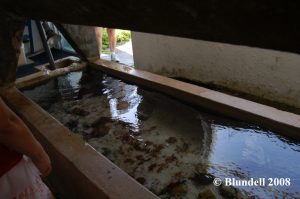It has been a decade since my work with the propagation and study of a drab looking unknown bore of a coral. From what started as an interesting idea is now a full blown fairytale known as the Blundell Buttons.
Background
As a young scientist I had a fascination with the marine ornamental hobby, and its role in the industry. I proposed a project one day to my fellow researchers and advisors. The plan was to track and document the collection, importation, and husbandry, and culture of a specific coral. We thought it could be an early attempt (if not the first) to track the coral over time. The overall goal was to show the potential for captive aquaculture.
Selecting the Coral
This project was going to take years. We needed a coral we could follow and track. Therefore a set of requirements were developed for selecting the coral
- it had to be something we could identify (differentiate from other corals)
- it had to be something we could track
That was about it. We found what seemed to be a perfect fit. We found a coral that was easily identifiable, rarely if ever seen in the hobby (at least in our location), easy to propagate, and not something we would expect to see in large numbers down the road.
What Is The Coral
Well we didn’t know for sure. At the time there was debate over the classification of the coral. The common identification book at the time was Reef Coral Identification by Humann (Humann 1993). This book did not list the coral, and rightfully so as the scientific community often sees corals as only being scleratinians, corals building skeletons. Humann did have this coral listed in his invertebrate book Reef Creature Identification (Humann 1992) and listed the coral as Palythoa grandis. Shortly following the onset of our project Julian Sprung wrote his wonderful book Corals a Quick Reference Guide (Sprung 1999). However, this book did not include the coral in question. A couple years later Eric Borneman wrote his masterpiece Corals (Borneman 2001) and this book listed the coral as Protopalythoa grandis. I asked Eric about this in person a few years ago and his answer was something like ‘I’m still not sure if that is correct’ (Blundell 2006). With such debate still taking place you can see how difficult it would have been to identify this coral years ago.
The Name
With a current debate on the naming of such coral in place, the University I was attending had trouble acquiring the export, import, and collection permits. The original paperwork came back to me and have approval for this unknown coral which the government had labeled as “Blundell Polyps” on some forms and as “Palythoa Blundell” on another. I guess it was easiest for them to just put my name on the permit with the coral since I would be the person clearing them through customs (both away and US). Little did I know what role that would play in later years. For several months these were termed Blundell coral or Blundell Polyps and the like until a hobbyist named Steve Lopez stated that he was calling them Blundell Buttons. And so the name was given.
Initiating The Project
So the project began. We had our coral and we were ready to use it. We were going to propagate this coral and track it through the hobby. Here is how we did it.
- I started with this coral and fragged off a couple of polyps. These polyps were then given away free to active members in my local aquarium club (Wasatch Marine Aquarium Society).
- I gave explicit instructions to each person receiving polyps that stated that these corals were to never be sold. They were to be grown, fragged, and shared with others.
- The new keepers were told that these corals were to be shared only with advanced aquarists who had the best chance of keeping the chain going. These second generation, third generation, forth generation, etc. owners were to continue the chain of producing free corals to expert reef keepers. A sort of pass it along free type of project to ensure survival.
- The new keepers of these corals were to explain to the next person (and so on down the chain) that these corals were to be grown as part of a project to document how well or how poorly corals are aquacultured and distributed. Therefore we wanted everyone to track where the cultured polyps were going from owner to owner down the line.
I then took the original colony and held it in my hand. I had to decide what to do with this ever important rock. I knew I couldn’t keep it. I can’t imagine how bad I’d feel if it died in my care. So I thought of all the tanks out there, and all the great reef systems. I tried to think of the best possible aquarium. I thought of where this coral would have the best chance of surviving for all time and eternity. And that is where I put the coral.
Conclusion
That was the plan. Now, how well did it work? The results will be in the next article.
Author Information
Adam Blundell M.S. is a hobbyist, lecturer, author, teacher, and research biologist. Adam is the director of the Aquatic & Terrestrial Research Team, a group which bridges the gap between hobbyists and scientists. Adam can be reached by email at [email protected].
References
- Blundell, A., (2006), Personal Communication with Eric Borneman. Salt Lake City, Utah.
- Borneman, E., (2001), “Aquarium Corals: selection, husbandry, and natural history”, TFH Publications. neptune City, New Jersey.
- Humann, P., (1993), “Reef Coral Identification”, New World Publications Inc. Jacksonville, Florida.
- Humann, P., (1992), “Reef Creature Identification”, New World Publications Inc. Jacksonville, Florida.
- Sprung, J., (1999), “Corals: a quick reference guide”, Ricordea Publishing. Miami, Florida.







0 Comments